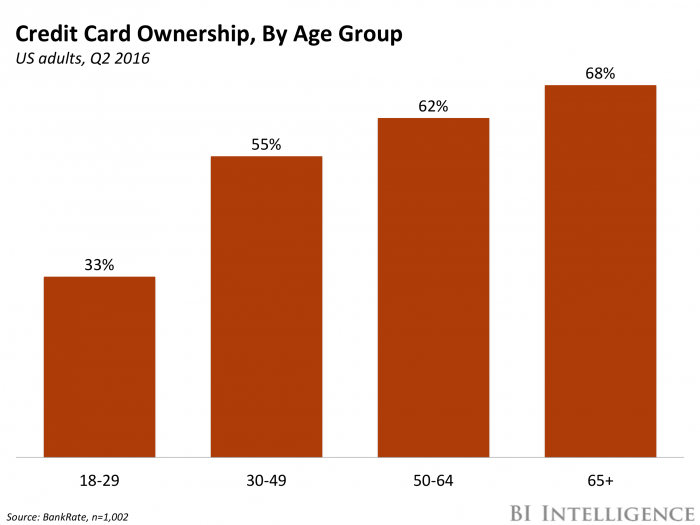 BII
BII
It’s not all that surprising that some millennials don’t own credit cards, but the percentage of this demographic that falls into this category is rather stunning.
New data from Bankrate reveals that young adults in the U.S. are concerned about holding credit, which in turn has led to low levels of card ownership. In fact, a mere 33% of adults ages 18 to 29 had a credit card in May 2016. This compared to 55% for those ages 30 to 49 and 68% for those older than 65.
Perhaps even more interestingly, this percentage of millennials has not changed much since a similar survey Bankrate conducted two years ago, which found that two-thirds of young adults had “no major cards.”
This lack of card ownership could stem from millennials’ low awareness about credit’s usefulness. Bankrate discovered that debt aversion was a major problem for millennials even though credit lines and mountains of debt do not always go hand in hand. This group of consumers also did not understand how credit history affects mortgage or auto loan applications in the future.
Credit card networks and issuers would benefit from providing appropriate education to the public. And some companies, such as Discover and Capital One, are already starting to do this through free credit scoring and financial literacy programs.
These companies could target customers with the right products through recommendations for their own credit card products based on credit scores. This could increase the number of clients with secured or low-limit credit credit products and give these companies a new base of loyal clients who might one day own more cards or apply for more loans.
But credit cards are not the only area in which millennials are subverting traditional habits. More millennials are moving toward digital banking, and as a result, they’re walking into their banks’ traditional brick-and-mortar branches less often than ever before.
This generation accounts for the greatest share of the U.S. population at 26% and the employed population at 34%, so it’s easy to see why their behaviors and preferences will have a profound effect on the future of the banking industry, particularly with regard to the way banks interact with their customers.
Third parties are expanding their role in providing services that consumers use to manage their money. And the more that role grows, the more it will disrupt the relationship between banks and their customers.
To paint a clearer picture of the future of the banking industry, John Heggestuen, managing research analyst at BI Intelligence, Business Insider’s premium research service, surveyed 1,500 banked millennials (ages 18-34) on their banking behaviors and preferences — from their preferred banking devices, to what banking actions they perform on those devices, to how often they perform them.
All of that rigorous research led to an essential report entitled The Digital Disruption of Retail Banking that dives deep into the industry and details what its future will look like.
Here are some of the key takeaways from the report:
- The bank branch will become obsolete. It will be some time before the final death rattle, but improving online channels, declining branch visits, and the rising cost per transaction at branches are collectively leading to branch closures.
- Banks that don’t act fast are going to lose relationships with customers. Consumers are increasingly opting for digital banking services provided by third-party tech firms. This is disrupting the relationships between banks and their customers, and banks are losing out on branding and cross-selling opportunities. For many banks, this will require further commoditization of their products and services.
- The ATM will go the way of the phone booth. Relatively low operational costs compared to bank branches, paired with customers’ preference for in-network ATMs, makes the ATM an attractive substitute for bank tellers. But as cash and check transactions decline, the ATM will become nonessential, ultimately facing the same fate as the physical branch.
- The smartphone will become the foundational banking channel. As the primary computing device, the smartphone has the potential to know much more about banks’ customers than human advisors do. The smartphone goes everywhere its user goes, has the ability to collect user data, and is already used for making purchases. Therefore, the banks that will endure will be those that offer banking services optimized for the smartphone.
In full, the report:
- Analyzes how millennials use bank branches and why – even though there are a large share of millennials who still use branches, making significant investments in these channels isn’t a good move for banks.
- Explains how mobile payments and mobile point-of-sale adoption by small retailers will make the ATM obsolete.
- Describes how digital channels, particularly the smartphone, will become the foundation of the bank-customer relationship.
The Digital Disruption of Retail Banking is how you get the full story on the future of banking.
To get your copy of this invaluable guide, choose one of these options:
- Subscribe to an ALL-ACCESS Membership with BI Intelligence and gain immediate access to this report AND over 100 other expertly researched deep-dive reports, subscriptions to all of our daily newsletters, and much more. >> START A MEMBERSHIP
- Purchase the report and download it immediately from our research store. >> BUY THE REPORT
The choice is yours. But however you decide to acquire this report, you’ve given yourself a powerful advantage in your understanding of how the digital age will disrupt retail banking.
 EXCLUSIVE FREE REPORT:
EXCLUSIVE FREE REPORT:5 Top Fintech Predictions by the BI Intelligence Research Team. Get the Report Now »













